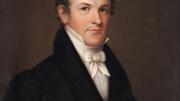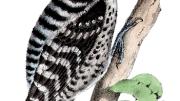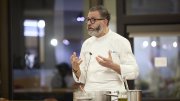In 1808, a day after landing in Philadelphia, Yorkshireman Thomas Nuttall found a common greenbrier, a plant new to him. The apprentice printer and aspiring naturalist took it to Benjamin Smith Barton of the University of Pennsylvania, who—struck by this fervor for botany—became Nuttall’s mentor, and in 1810 sent him on a major collecting expedition: to the Great Lakes, northwest to Winnipeg, and down the Missouri and Mississippi rivers. Nuttall, realizing he’d be welcome neither to the British in Canada nor the Plains Indians, eventually joined one of John Jacob Astor’s fur-trading parties. In prairies and woodlands he found plants new to science and collected species that had been discovered, but lost in transit, by the Lewis and Clark Expedition. Washington Irving’s historical account Astoria describes him as a “zealous botanist…groping and stumbling along a wilderness of sweets, forgetful of everything but his immediate pursuit.” In other first-hand stories, his use of his rifle to store seeds illustrates his obliviousness to peril in his single-minded quest to further science.
At journey’s end in 1812, with war looming, Nuttall sailed from New Orleans to London, but soon returned to Philadelphia. In 1816, he undertook a second major journey: down the Ohio River, to walk alone through Kentucky and Tennessee to the Carolinas. On his return he published The Genera of North American Plants and a Catalogue of the Species, to the Year 1817, which, American botanist John Torrey declared, “contributed more than any other work to the advance of accurate knowledge of the plants of this country.”
Next he financed his own expedition of some 5,000 miles down the Ohio and Mississippi into what is now Arkansas and Oklahoma, and published A Journal of Travels into the Arkansas Territory in 1821, partly to share “the wisdom and beauty of creation.” The book blends many discoveries of new plants with vivid accounts of his trials in finding them: drunken boatmen, river pirates, treacherous sandbars, and unmapped, mosquito-infested swamps. At his lowest, in “miseries of sickness, delirium, and despondence,” he had to flee through a stormy night, into quicksand and across a frigid river, from Indians trying to steal his horse. Yet he also told of Indians who rescued him when lost, and tried to arouse compassion for “the unfortunate aborigines…so rapidly dwindling into oblivion.” Three appendices, with linguistic notes on Southwestern tribes, would, he hoped, rectify the dismissal of Indian languages as “barbaric” and “create a new era in the history of primitive language.”
Nuttall was invited to Harvard in 1822 as a lecturer in natural history and curator of the botanical garden. He was popular with students, guiding them on woodland “rambles,” and the College allowed him botanizing absences, yet he grew restless, feeling that he was “vegetating” in Cambridge. “In that era,” writes historian Wayne Hanley, “Harvard was a veritable desert for a biologist.”
In 1832 he published a pioneering guide: a two-volume Manual of the Ornithology of the United States and Canada. Despite some errors, it was accurate enough that readers often assumed he was a trained ornithologist.Birds, he wrote, “play around us like fairy spirits”; he believed them capable of conjugal fidelity, education, and even “reflection.” His call to end their “wanton destruction” has been echoed by American conservationists ever since.
He left Harvard in 1833, and in 1834 joined the Wyeth Expedition to the Columbia River, which entered lands “no naturalist had ever traversed.” Ornithologist John Kirk Townsend marveled at his older colleague’s energetic collecting (though he once found Nuttall eating an owl he had saved as a specimen). They sent “bird skins” to the Academy of Natural Sciences and their friend John James Audubon, who used them as models for Birds of America. “Such beauties!” Audubon exclaimed. “Such rarities! Such Novelties!”
Nuttall continued on from Fort Vancouver to Hawaii and then to the virgin scientific territory of California. In 1836 a young sailor, Richard Henry Dana ’37, was amazed to find his old professor barefoot on a San Diego beach, gathering shells. To transport his barrels of specimens east, Nuttall had gained passage on Dana’s vessel, which was carrying hides to Boston. (The crew, bemused by Nuttall’s “zeal for curiosities,” called him “Old Curious.”) During the harrowing gales around Cape Horn, Dana wrote in Two Years before the Mast, Nuttall stayed below, but once past Tierra del Fuego he came on deck “hopping around as bright as a bird.” He begged the captain to let him explore an island “which probably no human being had ever set foot upon,” but the ship sailed on.
In Philadelphia he learned that an uncle had left him an estate in England, provided he stay there nine months each year. He lived out his days in Lancashire, but wrote, “I prefer the wilds of America a thousand times over” and returned once, for six months in 1847-48. The preeminent naturalist of his adopted country remained proud of the work he’d done “not in the closet but in the field.”
That work lives on through the common and scientific names of Western shrubs and trees like the Pacific dogwood (Cornus nuttallii), 44 marine genera and species, and three birds, including Nuttall’s woodpecker. And the first U.S. ornithological society, founded in 1873, bears his name. Members of the Nuttall Ornithological Club have included Theodore Roosevelt, Ernst Mayr, and Roger Tory Peterson. “Nuttall” still publishes ornithological research, building on its namesake’s groundwork, and meets monthly for lectures at the Harvard Museum of Comparative Zoology.









